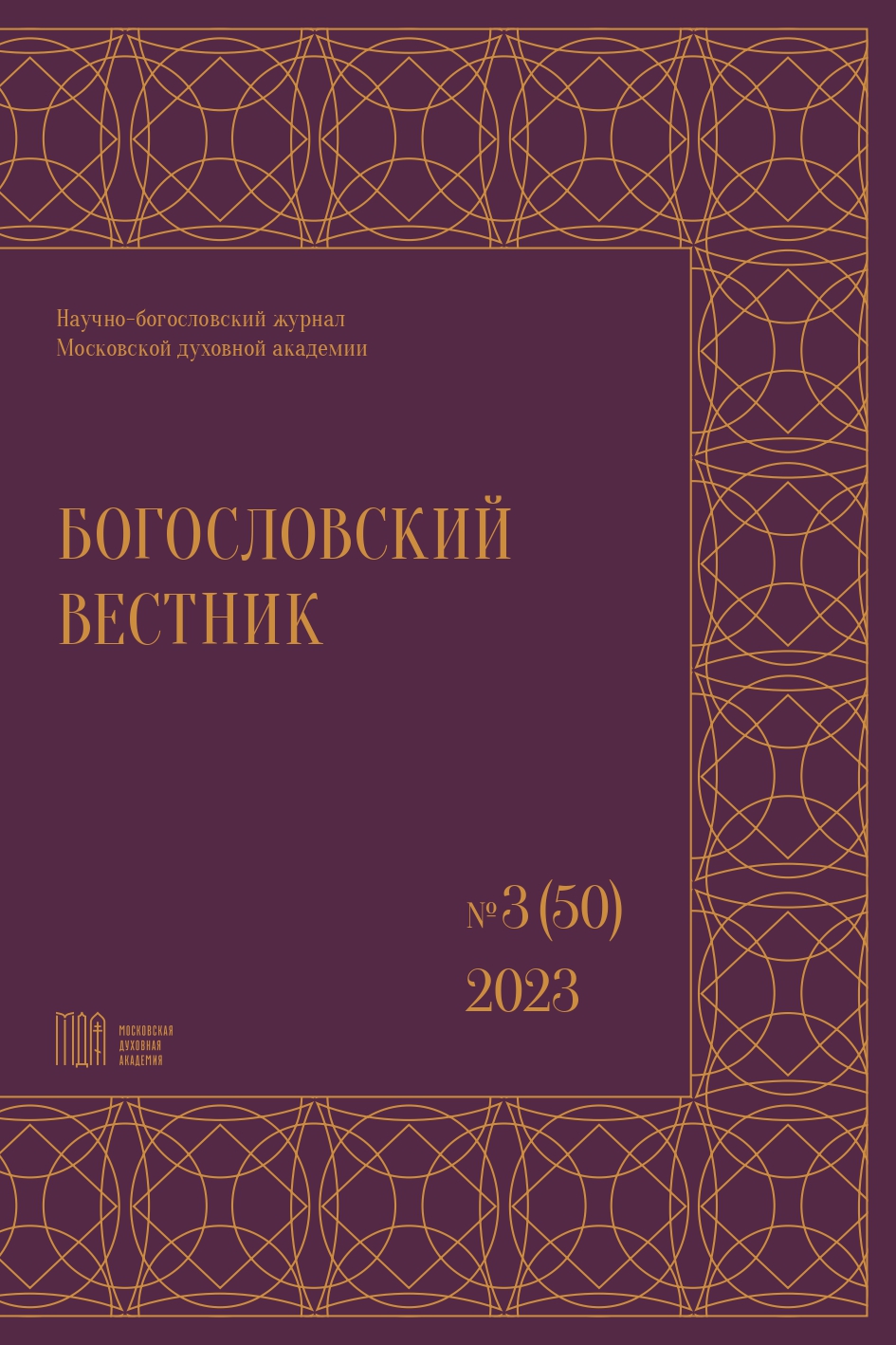Место нарративного анализа в контексте библейских исследований
DOI:
https://doi.org/10.31802/GB.2023.50.3.002Ключевые слова:
библеистика, литературный анализ, структурализм, метод читательского отклика, риторический анализ, нарративный анализАннотация
Настоящая статья представляет собой обзор современных научных методов в рамках библейских исследований. Внимание автора сосредоточено на литературном подходе к тексту Священного Писания и, в первую очередь, на такой его разновидности, как нарративный анализ. Автор предпринимает попытку классификации подходов к библейскому тексту. В её основу положена коммуникативная модель Р. Якобсона, на оси репрезентации которой располагаются исторические методы, а на оси коммуникации — литературные. В свою очередь, дифференцировать литературные подходы помогают базовые элементы коммуникативной триады: «автор», «текст», «читатель». Учитывая сосредоточенность исследователей на том или ином компоненте, выделяются подходы объективные (структурализм) и прагматические (риторический анализ и критика читательского отклика). Благодаря своим методологическим принципам нарративный анализ занимает среднее положение между этими подходами: учитывая его интерес к повествовательным структурам текста, можно считать нарративный анализ объективным методом; а учитывая его заинтересованность в образе подразумеваемого читателя — методом прагматическим.
Скачивания
Библиографические ссылки
Aristoteles. Rhetorica // Aristotelis Ars Rhetorica / ed. W. D. Ross. Oxford: Clarendon Press, 1959. [r1964]. P. 1–191. [1354a1 — 1420a8].
Augustinus Hipponensis. Confessiones // PL. T. 32. Col. 659–869.
Cicero. Ad M. Brutum Orator // Cicero. Orator ad M. Brutus / ed. K. W. Piderit. Leipzig: Teubner, 21876. P. 31–151.
Ephraem Syrus. In Genesim commentarii // Sancti Ephraem Syri in Genesim et in Exodum commentarii / edidit R.-M. Tonneau. (CSCO; vol. 152. Scriptores syri; t. 71). P. 1–121.
Ephraem Syrus. In Genesim commentarii // Sancti Ephraem Syri in Genesim et in Exodum commentarii / interpretatus est R.-M. Tonneau. (CSCO; vol. 153. Scriptores syri; t. 72). P. 1–103.
Gregorius Nazianzenus. Oratio XXX. Theologica quarta. De Filio // PG. T. 36. Col. 104C–133A.
Hieronymus.Interpretatio Chronicae Eusebii Pamphili cui subjecta sunt continenter fragmenta quae exstant operis graeci // PL. T. 27. Col. 33–40A.
Августин, блж. Исповедь / пер. М. Е. Сергеенко. Санкт-Петербург: Наука, 2013. (Литературные памятники).
Аристотель. Риторика / пер. с др.-греч. О. П. Цыбенко // Аристотель. Риторика. Поэтика. Москва: Лабиринт, 2000. С. 5–148.
Григорий Богослов, свт. Слово 30, о богословии четвёртое, о Боге Сыне второе // Творения иже во святых отца нашего Григория Богослова, архиепископа Константинопольского. Т. 1. Санкт-Петербург: Изд. П. П. Сойкина, [1912]. С. 429–444.
Ефрем Сирин, прп. Толкование на книгу Бытия // Ефрем Сирин, св. Творения. Т. 6. Москва: Отчий дом, r1995. [Сергиев Посад: СТСЛ, 1901]. С. 205–337.
Марк Туллий Цицерон. Три трактата об ораторском искусстве / под ред. М. Л. Гаспарова. Москва: Наука, 1972.
Цицерон. Оратор. [Электронный ресурс]. URL: http://ancientrome.ru/antlitr/t.htm?a=1423777005#065 (дата обращения: 27.03.2023).
Лехциер В. Л. Нарративный поворот и актуальность нарративного разума // Международный журнал исследований культуры. 2013. № 1 (10). С. 5–8.
Смолененкова В. В. Основы риторической критики. Москва: Форум, 2018.
Abrams M. H. The Mirror and the Lamp: Romantic Theory and the Critical Tradition. New York (N. Y.): W. W. Norton, 1958.
Alter R. The Art of Biblical Narrative. New York (N. Y.): Basic Books, 1981.
Barton J. Classifying Biblical Criticism // JSOT. 1984. № 29. P. 19-35.
Beardslee W. Literary Criticism of the New Testament. Philadelphia (Pa.): Fortress Press, 1969.
Boot W. The Rhetoric of Fiction. 2d ed. Chicago (Ill.): University of Chicago Press, 1983.
Burton M. Rhetoric and the New Testament. Minneapolis (Minn.): Fortress Press, 1989.
Chatman S. Story and Discourse: Narrative Structure in Fiction and Film. Ithaca (N. Y.): Cornell University Press, 1978.
Detweiler R. Derrida and Biblical Studies. Chico (Ca.): Scholars Press; The Society of Biblical Literature, 1982. (Semeia; № 23).
Culpepper A. Anatomy of the Fourth Gospel: A Study in Literary Design. Philadelphia (Pa.): Fortress Press, 1983.
Detweiler R. Reader-Response Approaches to Biblical and Secular Texts. Decatur (Ga.): Scholars Press, 1985. (Semeia; № 31).
Fish S. Literature in the Reader: Affective Stylistics // Self-Consuming Artifacts: The Experience of Seventeenth-Century Literature. Berkeley (Ca.); Los Angeles (Ca.): University of California Press, 1972. P. 383–427.
Fish S. Is There a Text in This Class? The Authority of Interpretative Communities. Cambridge (Mass.): Harvard University Press, 1980.
Fowler R. Let the Reader Understand: Reader-Response Criticism and the Gospel of Mark. Bloomington (Ind.): Indiana University Press, 1989.
Fowler R. Who is «The Reader» in Reader-Response Criticism? // Semeia. 1985. № 31. P. 5–23.
Frei H. The Eclipse of Biblical Narrative: A Study in Eighteenth and Nineteenth Century Hermeneutics. New Haven (Conn.): Yale University Press, 1974.
Holland N. The Dynamics of Literary Response. New York (N. Y.): W. W. Norton, 1968.
Holland N. Five Readers Reading. New Haven (Conn.): Yale University Press, 1975.
Iser W. The Implied Reader: Patterns of Communication in Prose Fiction from Bunyan to Beckett. Baltimore (Md.): Johns Hopkins University Press, 1974.
Iser W. The Act of Reading: A Theory of Aesthetic Response. Baltimore (Md.): Johns Hopkins University Press, 1978.
Kennedy G. New Testament Interpretation Through Rhetorical Criticism. Chapel Hill (N. C.): University of North Carolina Press, 1984.
Kingsbury J. The Christology of Mark’s Gospel. Philadelphia (Pa.): Fortress Press, 1983.
Kingsbury J. Matthew as Story. Philadelphia (Pa.): Fortress Press, 1986.
Kingsbury J. Reflections on «The Reader» of Matthew’s Gospel // NTS. 1988. Vol. 34. Iss. 3. P. 442–460.
Kugel J. L. The Idea of Biblical Poetry. Parallelism and Its History. New Haven (Conn.), 1981.
Longman T. Literary Approaches to Biblical Interpretation. Grand Rapids (Mich.): Zondervan, 1987.
Lowth R. Lectures on the Sacred Poetry of the Hebrew. London: T. Tegg and Son, 1835.
McKnight E. Bible and the Reader: An Introduction to Literary Criticism. Philadelphia (Pa.): Fortress Press, 1985.
McKnight E. Post-Modern Use of the Bible: The Emergency of Reader-Oriented Criticism. Nashville (Tenn.): Abington Press, 1988.
Muilenburg J. Form Criticism and Beyond // Journal of Biblical Literature. 1969. № 1 (88). P. 1–18.
Patte D. The Gospel According to Matthew: A Structural Commentary on Matthew’s Faith. Philadelphia (Pa.): Fortress Press, 1987.
Patte D. Structural Exegesis for the New Testament Critics. Minneapolis (Minn.): Fortress Press, 1989.
Perrin N. The Evangelist as Author: Reflections on Method in the Study and Interpretation of the Synoptic Gospels and Acts // BiblRes. 1972. № 17. P. 5–18.
Petersen N. Literary Criticism for New Testament Critics. Philadelphia (Pa.): Fortress Press, 1978.
Powell M. A. What is Narrative Criticism? Minneapolis (Minn.): Fortress Press, 1990.
Powell M. A. Types of Readers and Their Relevance for Biblical Hermeneutics // TSR. 1990. № 12. P. 19–34.
Resseguie J. Reader-Response and the Synoptic Gospel // JAAR. 1984. № 52. P. 307–324.
Rhoads D. Narrative Criticism and the Gospel of Mark // JAAR. 1982. № 50. P. 411–434.
Rhoads D., Michie D. Mark as Story: An Introduction to the Narrative of a Gospel. Philadelphia (Pa.): Fortress Press, 1982.
Robbins K. Jesus the Teacher. A Socio-Rhetorical Interpretation of Mark. Philadelphia (Pa.): Fortress Press, 1984.
Suleimann S., Crossman I. The Reader in the Text: Essays on Audience and Interpretation. Princetone (N. J.): Prencetone University Press, 1980.
Tannehill R. The Narrative Unity of Luke-Acts: A Literary Interpretation. Vol. 1: The Gospel According to Luce. Philadelphia (Pa.): Fortress Press, 1986.
Tannehill R. The Narrative Unity of Luke-Acts: A Literary Interpretation. Vol. 2: The Acts of the Apostles. Minneapolis (Minn.): Fortress Press, 1990.
Загрузки
Опубликован
Как цитировать
Лицензия

Это произведение доступно по лицензии Creative Commons «Attribution-ShareAlike» («Атрибуция — На тех же условиях») 4.0 Всемирная.








